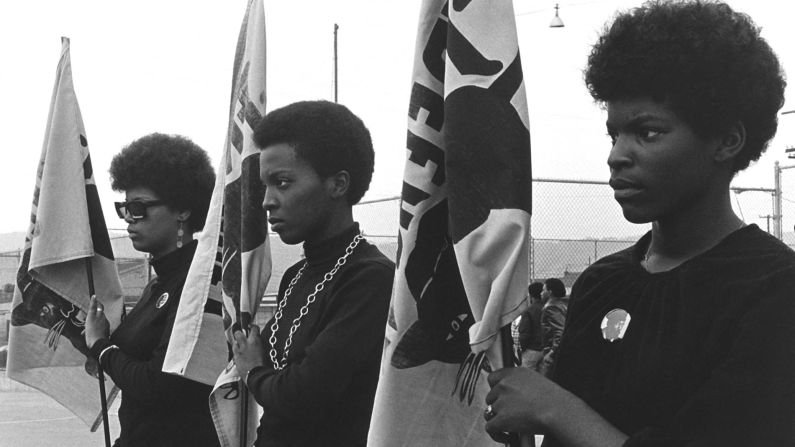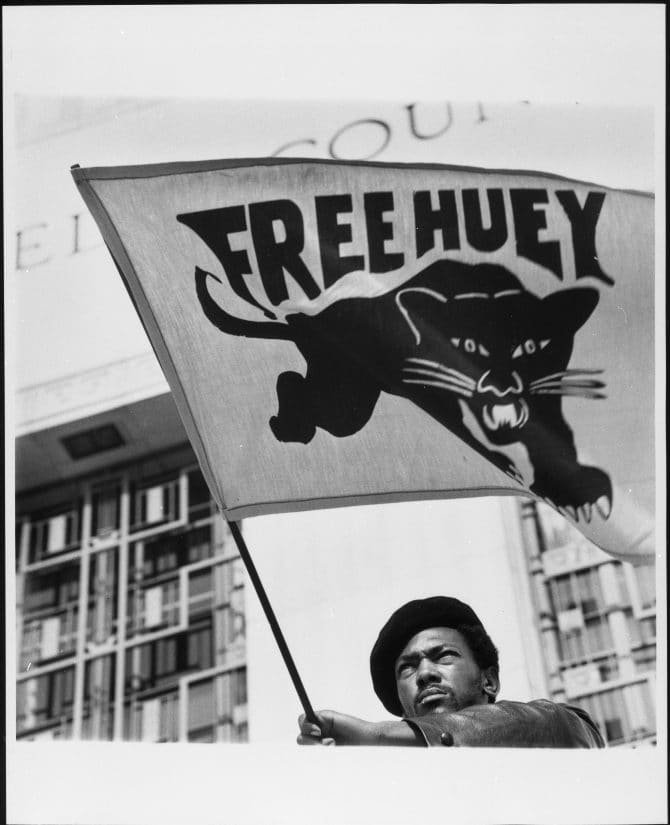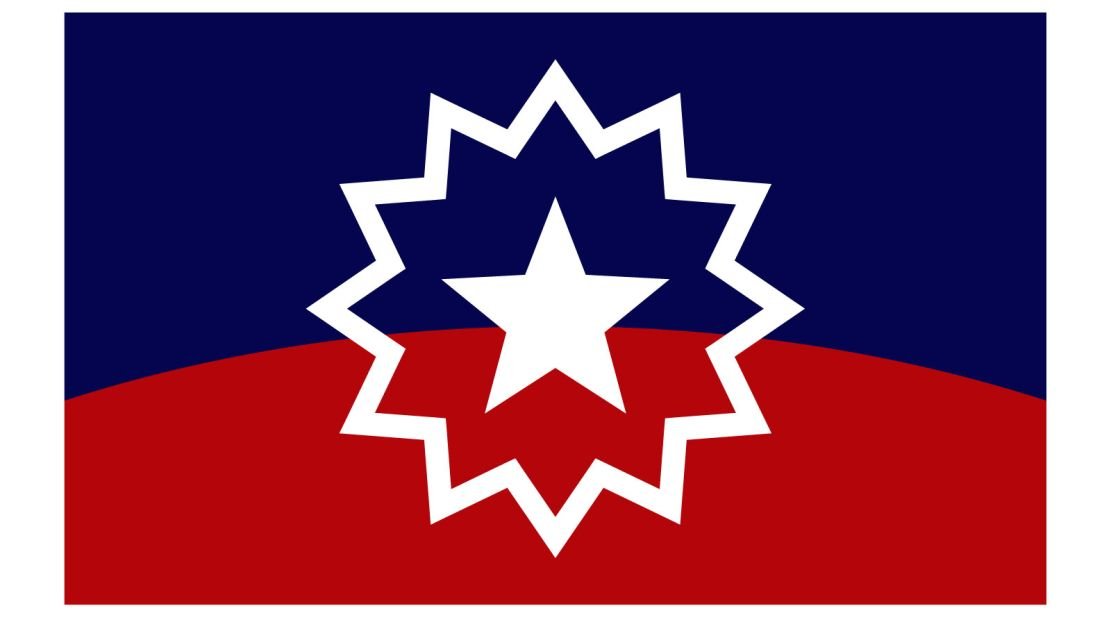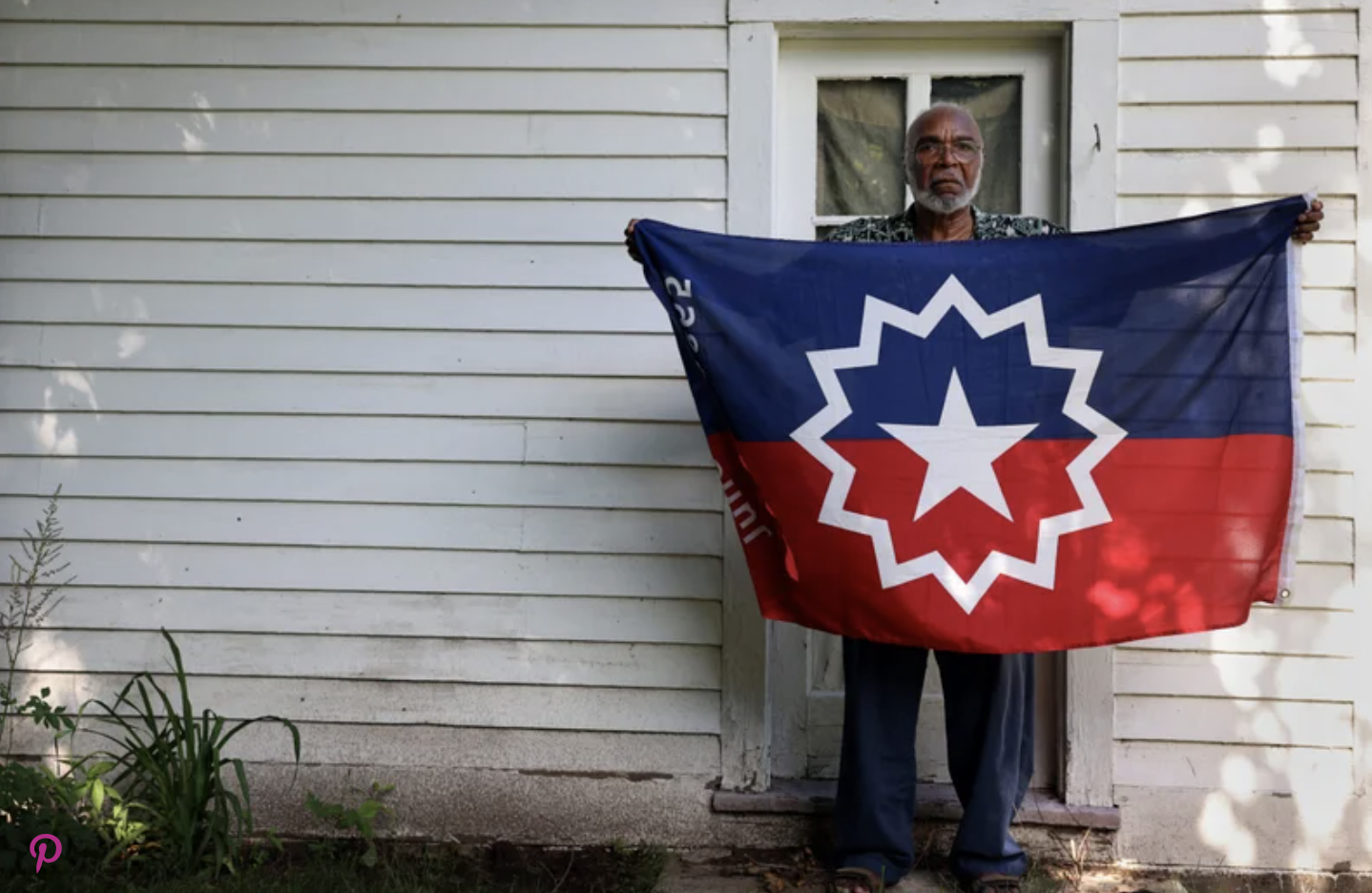Black American Flags Timeline
01 Pan-African flag — 1920
In 1920, Marcus Garvey introduced the Pan-African flag, marking a significant milestone as the first flag representing Black Americans. Garvey, a Jamaican political activist and the founder of the Universal Negro Improvement Association and African Communities League, conceived the flag as a response to the pervasive racism of the time. The inspiration for the flag came in part from a derogatory song titled “Every Race Has a Flag but the Coon,” which ridiculed and stereotyped African Americans.
The significance of the Pan-African flag was articulated in a 1921 speech by Garvey, published in Negro World in 1927. He declared, “Show me the race or the nation without a flag, and I will show you a race of people without any pride. Aye! In song and mimicry, they have said, ‘Every race has a flag but the coon.’ How true! Aye! But that was said of us four years ago. They can’t say it now.”
In the same year, the UNIA elaborated on the symbolism of the flag's colors: red symbolizes the blood shed for redemption and liberty; black represents the noble and distinguished race to which they belong; and green signifies the luxuriant vegetation of their Motherland.
Over time, the Pan-African flag transcended its original purpose and became a symbol embraced by newly liberated nations. Countries like Saint Kitts and Nevis, Kenya, South Sudan, Libya, Angola, Biafra, and Malawi incorporated the colors of the Pan-African flag into their national flags, signifying unity and solidarity with the Black struggle for freedom and equality.
02 Black Panther Party flag — 1966
In 1966, comrades Huey Newton and Bobby Seale established the Black Panther Party for Self-Defense in Oakland, California. That pivotal year, Newton and Seale encountered Stokely Carmichael, leader of the Student Nonviolent Coordinating Committee (SNCC), who passionately advocated for “Black Power” during a conference. Carmichael was then promoting the armed organizing endeavors of the Lowndes County Freedom Organization (LCFO), which prominently featured a black panther as its emblem.
According to Red Wedge magazine, Lowndes County was steeped in deeply conservative right-wing politics driven by white racists. Capitalizing on high illiteracy rates, these racists managed to influence voting by introducing a symbol of a rooster on the ballot, enabling illiterate whites to vote without the need to read or write. In response, Black residents in the area, including members of the LCFO, chose a local high school mascot, the black panther, as their symbol of political empowerment.
Newton and Seale embraced the symbolism of the black panther from Carmichael's organization. However, they found the panther symbol from Lowndes to be too robust for their purposes. Consequently, they enlisted the help of Emory Douglas, a student-artist and one of their early recruits, to redesign the panther symbol, making it smaller to reflect the party's commitment to serving the marginalized and underprivileged.
03 Black American Heritage Flag — 1967
In Newark, New Jersey, Melvin Charles and Gleason T. Jackson collaborated to design the Black American Heritage Flag. The impetus behind this creation stemmed from their childhood experiences of feeling unrepresented during parades and not resonating with the symbolism of the American flag. Charles shared with PBS that the flag's design features a gold blunted sword, symbolizing pride, and a fig wreath, representing peace, prosperity, and eternal life.
Drawing inspiration from the Universal Negro Improvement Association (UNIA), the flag incorporates symbolic colors: red signifies the sacrifices and struggles endured by Black people, while black embodies pride in Black pigmentation.
04 Juneteenth flag — 1977
In 1977, activist Ben Haith, founder of the National Juneteenth Celebration Foundation, collaborated with illustrator Lisa Jeanna to create the Juneteenth flag. This flag pays homage to both the American flag and the Texas (Lone Star State) flag through its red, white, and blue color scheme. The flag features a blue and red stripe, symbolizing a horizon, with blue representing the sky above and red signifying the cleansing of the ground soaked with the blood shed by African American slaves for the United States.
At the center of the flag is a white five-pointed star enclosed within a 12-point star, resembling a nova, to signify the birth of a new star. This new star represents a fresh start for the newly emancipated African Americans. In 2007, Haith updated the flag to include the date June 19, 1865, marking the final emancipation of enslaved individuals.
05 13 Stripes flag — 1989
Limited information exists about this flag; however, it made an appearance in Louis Cameron’s “The African American Flag Project.” This 2009 exhibit showcased a collection of paintings depicting African American flags, aiming to delve into the dialogue of symbolic representation within the African American community. According to an online archival catalogue, the 13-stripes flag originated in 1989 in South Central L.A., likely as a private endeavor.
One interpretation suggests that the 13 stripes may symbolize either the original colonies of America or the 13th amendment, which abolished slavery. Like many other flags, the colors red, black, and green align with Garvey’s Pan-African ideology. The addition of yellow or gold stripes could signify the wealth and richness of Black people, or perhaps the gold sourced from African mines.



06 David Hammons’ African-American Flag — 1990
David Hammons created the African American flag for the art exhibition “Black USA” held at an Amsterdam museum in 1990. This flag embodies the essence of a Black version of the American flag. According to Smithsonian magazine, Hammons described his inspiration for the flag: “Marcus Garvey designed the African American flag, which looked like the Italian flag except that it is red, black, and green. But it is so abstract, so pure, that the masses were frightened by it. I made my flag because I felt that they needed one like the U.S. flag but with black stars instead of white ones.” Hammons skillfully captures the dual consciousness inherent in the Black identity within the American experience.
His interpretation of the American flag sparked significant controversy. Just the year before, Congress had passed the Flag Protection Act, imposing penalties on those who desecrated the flag. However, by 1990, the Supreme Court had ruled the Flag Protection Act unconstitutional, citing violations of free speech rights.
07 The Harvey African-American Flag — 1991
In 1991, David and Tonya Harvey conceived a flag to symbolize the African-American community as a whole, distinct from any political affiliation. The idea emerged during a banquet where attendees sang the Negro National Anthem. Observing the lack of a focal point, the couple set out to create the African-American Flag. The red, white, and blue stripes at the top and bottom borders represent the contributions of African-Americans to America. Despite the traumatic history of Black people on American soil, there remains an undeniable connection to the country.
The side borders feature green, yellow, and black stripes symbolizing the abundant life in Africa, the richness of its resources, and the inherent dignity of African skin. The purple base of the flag signifies the regal heritage of African-Americans. Positioned at the center is an eight-pointed black star, representing the eight letters in the word "Africans," which serves as an acronym for Aspirations, Family, Righteousness, Individuality, Community, Ability, Nobility, and Scholarship.
Surrounding the black eight-pointed star are four yellow diamond shapes, intended to depict flashes of light symbolizing perseverance, love, knowledge, and spirituality. Speaking to Morgan Magazine in 2002, Harvey's widow expressed, “He wanted the flag to help pull African Americans together…and to remind us that each one of us can succeed and do well.”


08 NuSouth flag — 1993
In 1993, a clothing company based in Charleston, South Carolina, known as NuSouth Apparel, took a bold step in reimagining the Confederate flag. Founded by Angel Quintero and Sherman Evans, the company embarked on a marketing campaign for a local hip-hop group called DaPhlayva, aiming to elevate Southern rap identity amidst the brewing coastal tensions between the East and the West.
Drawing inspiration from David Hammons' African-American flag and Marcus Garvey's Pan-African color scheme, NuSouth presented three variations of the Confederate flag. These versions featured red, black, and green backgrounds respectively, with alternating colors for the stars and bars. The brand quickly gained attention when a Black teenage girl was suspended from school for wearing a NuSouth shirt, with the principal citing the "wrong colors."
The NuSouth flag swiftly emerged as a symbol of rebellion in the 1990s, notably appearing in footage from the Million Man March in Washington, D.C. Quintero and Evans even advocated for replacing the Confederate flag at the South Carolina State House with the NuSouth flag. Although NuSouth Apparel ceased operations in 2003, Quintero and Evans continue to curate the brand's history on social media.
In 2020, Evans reflected on the use of provocative imagery, stating, “There is a lot of fear in something that is so liberating and free… People say they want freedom but what does that look like?”
09 African-American Flag House flag — 1995
The African American Flag House developed their flag between 1993 and 1994 in Charleston, South Carolina, with the hope that it would serve as “a positive and unifying symbol representing the significant historical contributions of African Americans.” Each star on the flag carries a profound meaning:
1. The First Star signifies that all humanity originates from Africa.
2. The Second Star highlights Africa's role in fostering the earliest civilizations and kingdoms.
3. The Third Star symbolizes the tragic abduction of Africans from their ancestral homeland.
4. The Fourth Star solemnly remembers the horrors of the Middle Passage and the millions who perished.
5. The Fifth Star recalls the era of enslavement before its abolition in America.
6. The Sixth Star honors those who resisted injustice and oppression.
7. The Seventh Star pays tribute to African Americans who defended the Constitution.
8. The Eighth Star celebrates the resilience and unity of the African American family.
9. The Ninth Star represents the perseverance and triumph over adversity.
10. The Tenth Star acknowledges African American achievements in realizing the American dream.
11. The Eleventh Star urges African Americans to explore their history and embrace their heritage.
12. The Twelfth Star signifies accomplishments through diligence, scholarship, and determination.
13. The Thirteenth Star symbolizes Pan African unity.
14. The Fourteenth Star guides African Americans towards a future of honor and truth.
The flag's colored stripes convey additional symbolism:
- Green Stripes: Remind of the Earth and humanity's roots in African soil.
- Yellow Stripes: Represent moral excellence and spiritual wealth as African Americans engage with diverse cultures.
- Black Stripes: Highlight African American families' contributions to America across economic, spiritual, social, and political spheres.
- White Stripes: Caution against threats to freedom and constitutional rights.
- Blue Stripes: Bridge the gap between African Americans and Africa.
- Red Stripes: Symbolize the passionate resolve and sacrifices made in the pursuit of freedom.
10 African-American Flag of Inclusion — 1999
In 1999, Cecil W. Lee, a painter, photographer, and digital artist based in New York, introduced the “African American Flag of Inclusion” at a solo art exhibition held at Gallery X in Harlem. Lee's innovative flag design blends elements of the American flag with Marcus Garvey's Pan-African flag. By replacing the top seven stripes of the U.S. national flag with the pattern of the Black Liberation flag, Lee aimed to symbolize "all African Americans regardless of their individual beliefs or political affiliations."
According to Lee's website, the components of the African American Flag of Inclusion convey specific meanings: red symbolizes life, blood, family, vitality, and unity; black represents the people, strength, depth, and influence; green signifies the earth, evolution, growth, and progress; while the stars and stripes embody principles of equality and unity.

11 Black American Flag — 2003
The Black American Flag, originating around 2003, was suggested as a symbol for the African American or Black American community. Its design features a black base, symbolizing two key facets of Black identity: the historical backbone rooted in slavery and the unity in pursuit of social change. Positioned in the top left corner is a solitary white star representing the North Star. Historically, the North Star guided enslaved ancestors to freedom, serving as a beacon of hope. Similarly, it serves as a guiding light for Black Americans towards a brighter future.

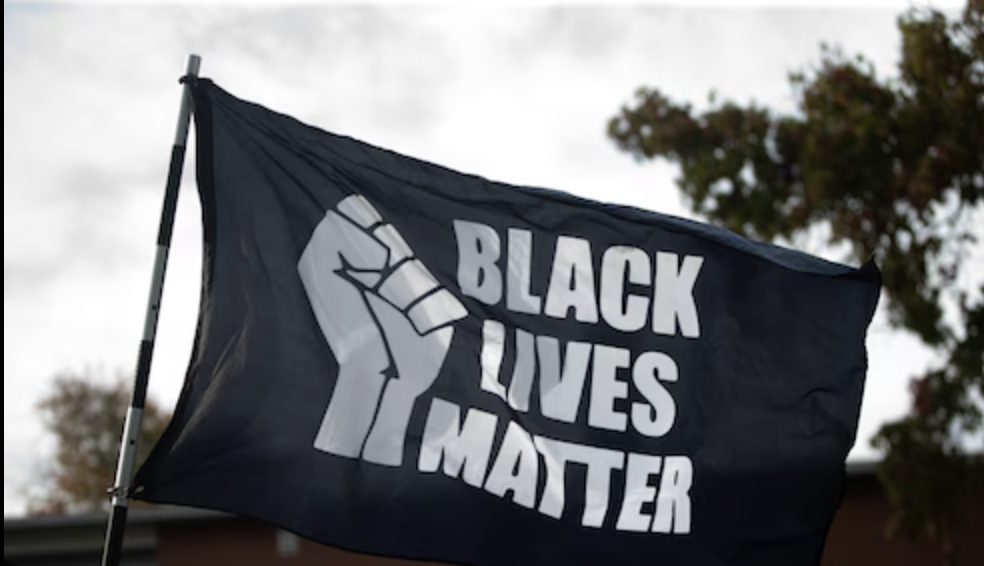

Black Lives Matter Flag
The Black Lives Matter flag serves as a powerful symbol of unity, justice, and resilience in the fight against racial inequality and systemic oppression. With its bold colors and meaningful elements, the flag stands as a beacon of hope and solidarity for Black communities worldwide.
At its heart lies the significance of each component: the vibrant black background represents the strength and resilience of Black individuals and communities in the face of adversity. The bold yellow letters spell out the rallying cry, "Black Lives Matter," a declaration echoing the urgent call for equality, justice, and an end to racial violence and discrimination.
Surrounding the lettering are meaningful symbols that amplify the message of the movement. The raised fist, a potent emblem of solidarity and resistance, symbolizes the ongoing struggle for liberation and empowerment. Encircled by a ring of stars, each representing the interconnectedness and unity of Black individuals and allies in the fight for justice and equality.
As it waves proudly, the Black Lives Matter flag serves as a reminder of the ongoing struggle against racial injustice and a beacon of hope for a future where every Black life is valued, respected, and celebrated.

12 Foundational Black Flag — 2020
The Foundational Black Flag, emerging in 2020, gained prominence online through the influence of controversial media figure Tariq Nasheed. This flag represents Foundational Black Americans, who are recognized as the descendants of Black slaves integral to building the United States from its inception. The movement surrounding this flag is contentious due to its anti-Pan-African sentiments.
According to the movement's website, Foundational Black Americans reject the notion that the history of Black people in America began solely with the Trans-Atlantic Slave Trade in the early 1600s. Instead, they assert that FBAs arrived in North America as early as 1526, purportedly brought from the Caribbean by a figure named Lucas Vázquez de Ayllón.
The Foundational Black Flag comes in two variations. The first features a maroon background with a gold emblem depicting two axes and a torch beneath five gold stars. The maroon hue pays homage to the Maroon Africans, who established settlements separate from slavery and often intermingled with Indigenous communities. The torch and axes symbolize the weapons wielded in the struggle for freedom, while the five stars represent the states where numerous Maroon societies thrived: Virginia, North/South Carolina, Florida, Mississippi, and Louisiana.

13 Foundational Black American flag — 2020
Introduced in 2020, the Foundational Black American flag features the traditional colors of the United States, paying homage to Grace Wisher, a free African American woman who, as a child, was indentured to Mary Pickersgill, the renowned seamstress of the Star-Spangled Banner flag.
The flag showcases three white stars, each representing a distinct ethnic group within the Foundational Black American community: the Black aboriginal people of North America, Black explorers and traders who navigated the Americas pre-Columbus, and the individuals forcibly brought from Africa to the Western Hemisphere.
At the center of the flag is the iconic Black power fist from the 1960s, symbolizing strength and solidarity. Surrounding the fist are red and blue olive branches, symbolizing unity among Black aboriginals and Black enslaved individuals.
The flag also features nine red pillars, representing significant slave rebellions throughout history. One of the pillars is partially obscured behind the fist, signifying a rebellion often overlooked or hidden in historical narratives.




